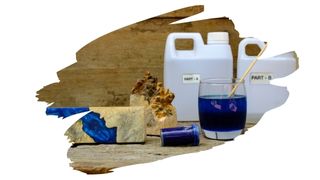Epoxy is one of the most water-resistant sealers you can use to safeguard wood from moisture and water-damage. Beyond that, it’s a fantastic glossy resin that enhance the look of tables and floors…plus it’s durable to boot.
Still, despite it’s durability, unsealed epoxy can quickly start to lose it’s glossy sheen over time — so this is where polyurethane comes in.
A thin coat of polyurethane can add just the right finishing touch to a solid epoxy surface.
But, what if you’re still waiting on epoxy to solidify, and it still feels tacky to the touch. Can it take on a few coats of polyurethane anyway?
Well, in this post, you’ll learn the difference between a dry epoxy and cured epoxy — and what it means for polyurethanes adhesion onto this wood sealer. You will also find out the main reason why epoxy still feels tacky — despite your best efforts to get it to dry.
And keep reading to discover the two key things you can do to fix tacky epoxy resin.

This post may contain affiliate links to products that we receive a commission for (at no additional cost to you). Learn more here.
Can You Honestly Apply Polyurethane Over An Epoxy Finish?
Well, as long as that epoxy resin has dried and cured, then a polyurethane coat will adhere to it. But the key word here is ‘cured’.
You see, dry epoxy resin can still feel tacky to the touch.
However, a wholly cured epoxy resin will have hardened all the way through, and won’t feel sticky. This then leaves behind an uncontaminated surface for polyurethane to stick onto.
Related Post: Can You Apply Epoxy Over Polyurethane? (Your Questions Answered!)
What About Tacky Epoxy? Can You Get Polyurethane To Stick Onto It?
No, far from it. One of the basic things about applying polyurethane is that it needs a ‘clean’ surface to stick to.
What this means is that the surface shouldn’t be contaminated with solvents, oils, or other chemicals that can effect adhesion.
Now, the thing about tacky epoxy is that it hasn’t cured. The resin in it can still be wiped off by mere touch, and it’s likely still off-gassing too.
All of which means that, if you apply polyurethane onto a tacky epoxy surface, the polyurethane will peel and flake off.
What Is Off-Gassing? Off-gassing refers to the fumes, (otherwise known as Volatile Organic Compounds), that release into the air off of finishes, sealants, paints, etc.
Wait A Second. I Thought Epoxy Dries And Sets Fairly Quickly…
Well, drying and curing are actually two different processes that a wood finish or sealer goes through.
Drying is a process of evaporation, turning a liquid into a solid film that is still soft to the touch. But, curing is a chemical reaction that transforms the epoxy into a hard durable substance.
Now, what this means is that it only takes around 12-24 hours for epoxy to dry and set. But, it takes much longer for it to cure all the way through.
Sometimes, it can take as much as 4 weeks to cure, depending on room temperature.
Related Post: Can You Varnish Over Epoxy? (The 3 Most Frequent Problems Solved!)
So Why Is My Epoxy Still So Sticky Even After Drying?
Usually an incorrect ratio of hardener to resin, is the key cause.
This is particularly the case if you happen to get the measurements of them wrong. Or they aren’t blended together well enough.
In either case, that imbalance will completely throw the curing time of epoxy right off.
Related Post: Can You Use A Router To Even Out Epoxy Resin Edges?
Got It. So Can You Fix Sticky Resin? What Can You Do With Epoxy That Won’t Dry?
OK, so at this point you pretty much have two options;
1). Turn Up The Dry Heat
Increasing the heat in the room by just 50° Fahrenheit (10° Centigrade) can halve the time it takes for epoxy to cure.
You’ll also want to create an environment of dry heat around the epoxy. So, use a dehumidifier to help manage the humidity levels in the room, and maintain RH (Relative Humidity) levels of between 45-55%.
But, sometimes raising the heat simply isn’t enough to solve the problem. In which case…
2). Scrape It Off
Grab a paint scraper and scrape off the top layer of the still tacky resin.
If the resin doesn’t scrape off easily, you’ll need to get some low-grit sandpaper (80-grit to 100-grit) and sand away what you can.
Afterwards, once you’ve removed the problematic resin as best you can, you can apply another top layer of epoxy over it.
Related Post: Will An Epoxy Top Coat Stop Wood From Splitting?
Does Epoxy Always Need Sanding Before Applying A Polyurethane Top Coat?
Absolutely. In fact, this is best practice for applying polyurethane onto any surface (including over another coat of polyurethane).
You see, polyurethane will peel off a surface that is very smooth. And epoxy can leave behind an almost glass-like surface.
So sanding epoxy will roughen up the epoxy enough so that polyurethane will adhere to it.
Now, you will still need to make sure the surface is free of contaminants (such as dust, dirt, and oils). So, after sanding, clean the newly roughened surface afterward with a lightly dampened (not wet) rag.
Does Epoxy Resin React With Polyurethane? It won’t, provided the epoxy resin has cured. Applying polyurethane onto a wholly cured epoxy surface is perfectly fine.
To Wrap Up, Here Are The 3 Key Takeaways From This Post…
- 1). A new coat of polyurethane will only stick and stay on uncontaminated surfaces.
- 2). As long as epoxy has dried and cured all the way through, a top coat of polyurethane will adhere to it.
- 3). If epoxy still feels tacky to the touch, that means that while it may have dried, it has not completely cured.
References:
Network formation in curing of epoxy resins | Springer.com



